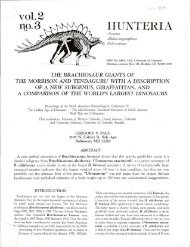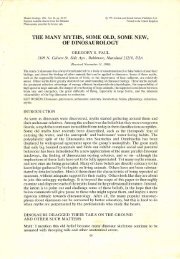Dinosaur models: the good, the bad, and using - Gregory S. Paul
Dinosaur models: the good, the bad, and using - Gregory S. Paul
Dinosaur models: the good, the bad, and using - Gregory S. Paul
Create successful ePaper yourself
Turn your PDF publications into a flip-book with our unique Google optimized e-Paper software.
142 Dinofes~ International Proceedings<br />
Transactions of <strong>the</strong> Twenty-Second North American Wildlife Conference:<br />
119-132.<br />
McFARLAN, D. ANDMCWHIRTER,N. D. 1989. The Guinness Book of<br />
Records. Guinness Publishing Ltd, Engl<strong>and</strong>. .<br />
MCGowAN, C. 1979. The hindlimb musculature of <strong>the</strong> brown kiwi,<br />
Apteryx australis mantelli. Journal of Morphology 160:33-74.<br />
MCGINNIS,H. J. 1982. Carnegie's <strong>Dinosaur</strong>s. Carnegie Institute, Pittsburgh.<br />
MENSINK,V. H. ANDMERTMANN,D. 1984. <strong>Dinosaur</strong>ier-Fahrten (Gigantosauropus<br />
asturiensis n. g. n. sp.; Hispanosaurus hauboldi n. g.<br />
n. sp.) im Jura Asturians bei La Griega und Ri<strong>bad</strong>esella (Spanien).<br />
Neues Jarbuch fur Geologie und Palaontologie Monatshefte, 1984:<br />
405-415.<br />
MORRIS, W. J. 1978. A giant hadrosaurian dinosaur from Baja California.<br />
Journal of Paleontology, 46:777-779.<br />
OLSHEVSKY,G. 1988. Sensational giant sauropod pelvis found at Dry<br />
Mesa. Archosaurian Articulations, 1:25-27.<br />
OWEN-SMITH, R. N. 1988. Megaherbivores. Cambridge University<br />
Press, Cambridge.<br />
PAUL, G. S. 1987. The science <strong>and</strong> art of restoring <strong>the</strong> life appearance<br />
of dinosaurs <strong>and</strong> <strong>the</strong>ir relatives: a rigorous how-to guide, 4-49. In<br />
Czerkas, S., <strong>and</strong> Olsen, E. (eds.), <strong>Dinosaur</strong>s Past <strong>and</strong> Present. Natural<br />
History Museum of Los Angeles County, Los Angeles.<br />
---, 1988a. The brachiosaur giants of <strong>the</strong> Morrison <strong>and</strong> Tendaguru<br />
with a description of a new subgenus, Giraffatitan, <strong>and</strong> a comparison<br />
of '<strong>the</strong> world's largest dinosaurs. Hunteria, 2(3):1-14.<br />
---, 1988b. Predatory <strong>Dinosaur</strong>s of <strong>the</strong> World. Simon & Schuster,<br />
New York.<br />
---, 1990. Book reviews. Historical Biology 3:313-318.<br />
---, 1995. Fat ankylosaurs-really, really fat ankylosaurs. The <strong>Dinosaur</strong><br />
Report, Spring:6-7.<br />
---, 1996a. The Complete Illustrated Guide to <strong>Dinosaur</strong> Skeletons<br />
(with English translation). Gakken, Tokyo.<br />
---, 1996b. The art of Charles R. Knight. Scientific American,<br />
274(6):74-81.<br />
---, AND CHASE, T. L. 1989. Reconstructing Extinct Vertebrates,<br />
239-255. In E. R. S. Hodges (ed.), The Guild H<strong>and</strong>book of Scientific<br />
Illustration. Van Nostr<strong>and</strong> Reinhold, New York.<br />
---, AND LEAHY, G. D. 1994. Terramega<strong>the</strong>rmy in <strong>the</strong> time of<br />
titans: restoring <strong>the</strong> metabolics of colossal dinosaurs. Paleontological<br />
Society Special Publication (DinoFest), 7:177-198.<br />
RICH,T. H. ANDHALL,B. 1979. Rebuilding a giant. Australian Natural<br />
History, 19:310-313.<br />
RUBEN,J. A., LEITCH,A., ANDHILLENIUS,W. 1995. Respiratory turbinates<br />
<strong>and</strong> <strong>the</strong> metabolic status of some <strong>the</strong>ropod dinosaurs <strong>and</strong> Archaeopteryx.<br />
Journal of Vertebrate Paleontology, 15(Suppl. to 3):50A.<br />
RUSSELL,D. A. 1989. An Odyssey in Time: The <strong>Dinosaur</strong>s of North<br />
America. National Museum of Natural Sciences, Ottawa.<br />
---, BELAND,P., ANDMcINTOSH, J. S. 1980. Paleoecology of <strong>the</strong><br />
dinosaurs of Tendaguru (Tanzania). Memories de la Societe Geologique<br />
de France (NS), 59: 169-176.<br />
SHOSHONI,S. L., SHOSHONI,J., ANDDAHLINGER,F. 1986. Jumbo: Origin<br />
of <strong>the</strong> word <strong>and</strong> history of <strong>the</strong> elephant. Elephant, 2(2):86-111.<br />
APPENDIX:SKELETALRESTORATIONSANDMASS<br />
ESTIMATESFORHERBIVOROUSDINOSAURS<br />
Most of <strong>the</strong> skeletons were restored on paper <strong>and</strong> modeled at constant<br />
femur lengths of 105 <strong>and</strong> 52.5 mrn respectively. It would be ideal to<br />
present all skeletons at <strong>the</strong> same scale, but <strong>the</strong> great size range of dinosaurs<br />
makes this impractical. The skeletons <strong>and</strong> profiles are <strong>the</strong>refore<br />
reproduced in five common scales, one for each category of size-small<br />
(Figs. 1,2; scale bar equals 1 m), medium (3,4; 2 rn), large (5-8; bar 2<br />
m), sauropods (9-11; 4 m), super giants (12; 4 m). The human figure<br />
is 1.64 m tall (5' 4"). Mass estimates (in large bold numerals) are in<br />
kilograms (= 2.2 lb.) for <strong>the</strong> small <strong>and</strong> medium category, tonnes (=<br />
2.2 tons) for <strong>the</strong> rest. The symbol - means approximate, <strong>and</strong> applies<br />
to specimens that are too incomplete to estimate <strong>the</strong>ir mass more accurately.<br />
For some unusually large but fragmentary individuals profiles<br />
have been prepared (<strong>the</strong> preserved bones are sometimes included).<br />
These are not true rigorous restorations, but are intended to give a better<br />
idea of <strong>the</strong> possible dimensions <strong>and</strong> bulk of <strong>the</strong>se giants.









